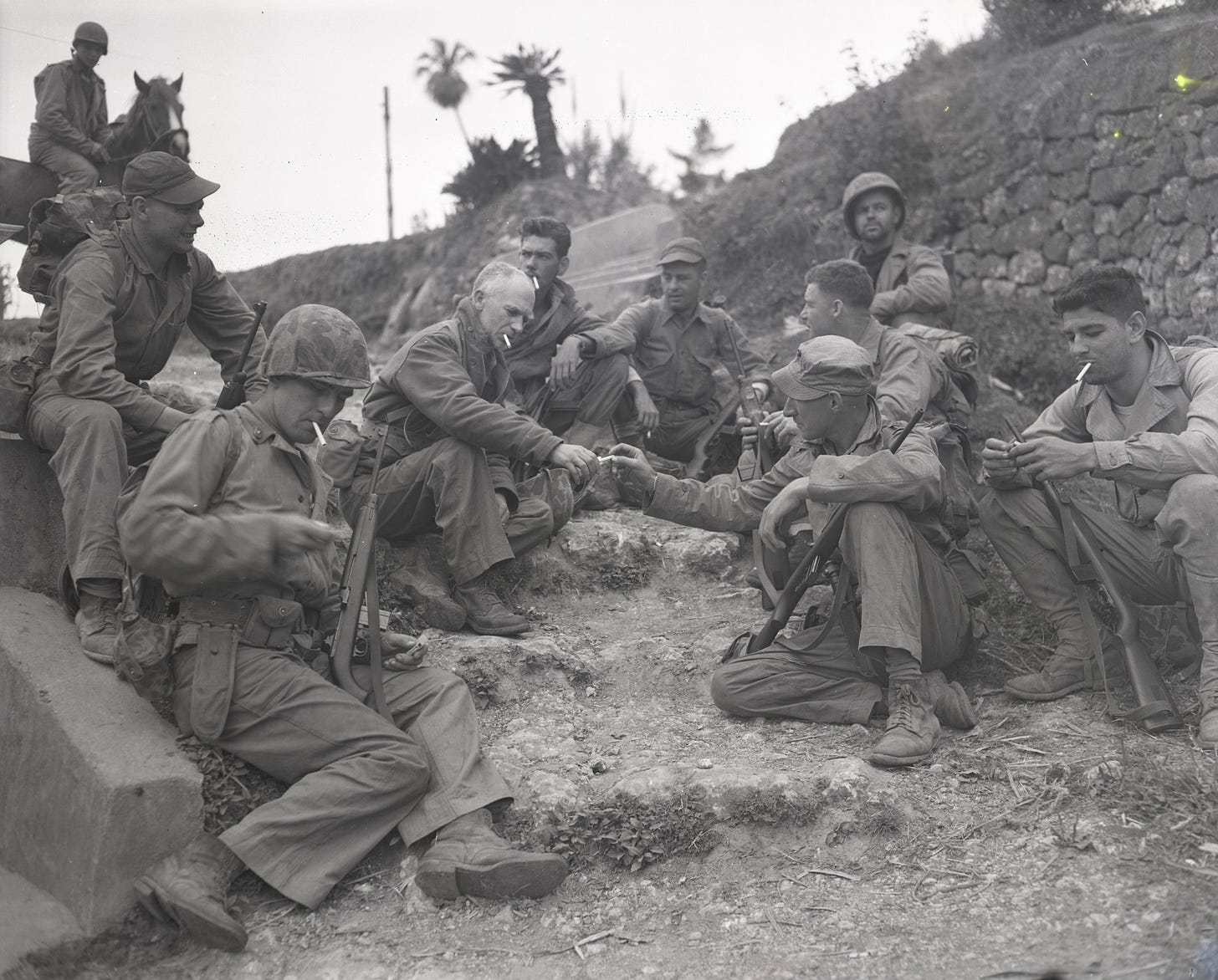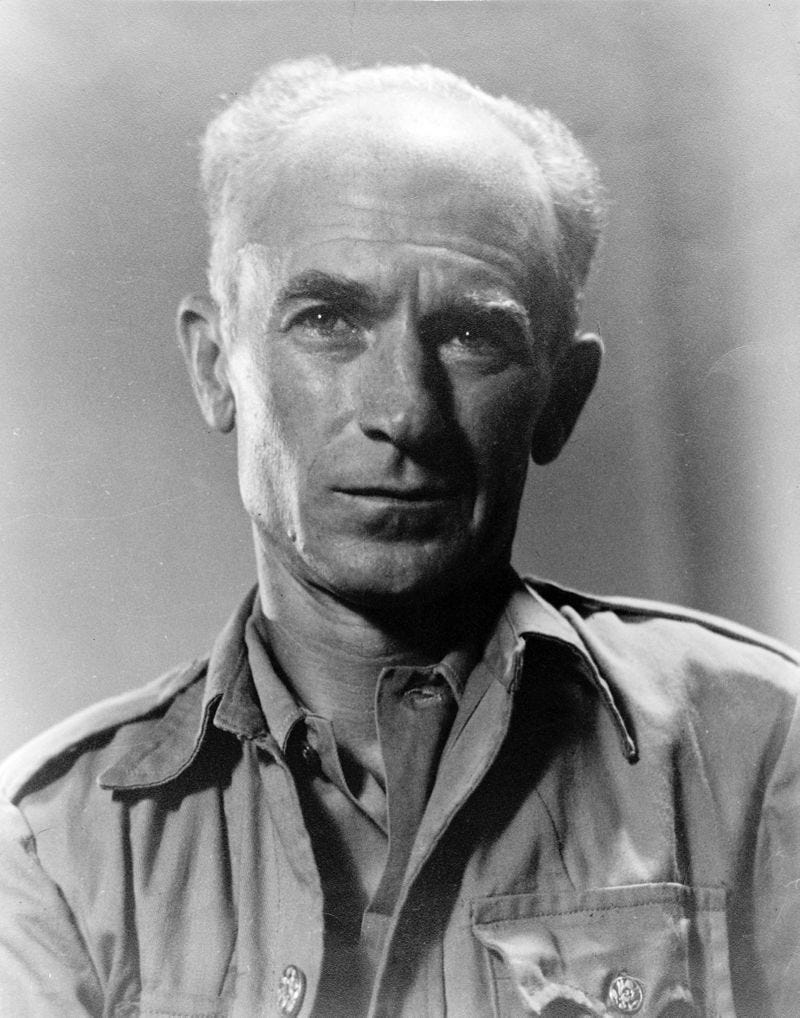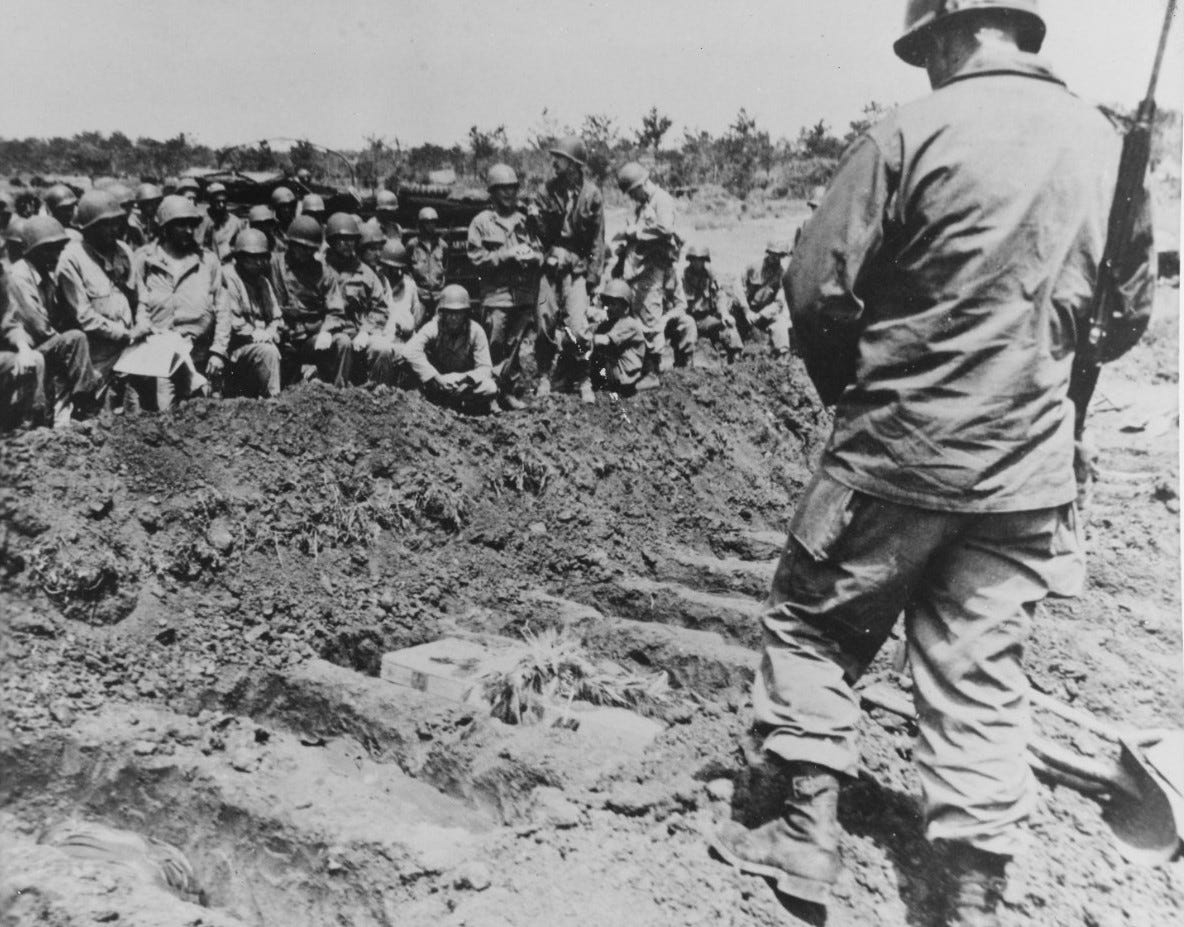Ernie Pyle killed on Ie Shima
Lt. Col. Joseph B. Coolidge was close to tears when he came back down the road.
Coolidge, called “Cal” by his friends, was a military man to the core: grandson of a Civil War veteran, 1931 graduate of West Point, a career soldier who had served with the 77th Infantry Division in action at Guam, Leyte, Okinawa and had risen to command of the 305th Infantry Regiment.
He had seen more than enough of the horrors of war, but what he had just witnessed left him visibly shaken.
Ernie Pyle was dead, shot in the head by a Japanese machine-gunner.
Pyle had landed on tiny Ie Shima, just off Okinawa, with the 305th on April 16, 1945. On the morning of the 18th, he set out to see some of the action, riding along in Coolidge’s jeep.
The officer shared what happened next with Associated Press photographer Grant MacDonald, who was covering the fighting on the island:
We were moving down the road in our jeep. Ernie was going with me to my new command post. At 10 o’clock we were fired on by a Jap machine gun on a ridge above us. We all jumped out of the jeep and dived into a roadside ditch.
A little later Pyle and I raised up to look around. Another burst hit the road over our heads and I fell back into the ditch. I looked at Ernie and saw he had been hit.
He was killed almost instantly, the bullet entering his left temple just under his helmet.
Coolidge left a man at the site of the ambush to guard Pyle’s body and moved back to report the news. It would be about four hours before a party of litter bearers that included a chaplain could safely bring Pyle back to American lines.
MacDonald felt a deep sorrow at Pyle’s loss, MacDonald wrote, but the officer’s thoughts went straight to his enlisted men.
“They have lost their best friend,” Coolidge said.
Pyle hadn’t been with the 77th for long, but that thought illustrated the kinship the common soldier had come to feel with the diminutive Indiana native.
The top brass and public relations officials in the Pacific had been overjoyed when Pyle decided to ship out to that theater in early 1945 after a few months of much-needed recuperation from all the fighting he had seen in North Africa, Sicily, Italy and France.
The man himself, however, was not nearly as enthusiastic, and he made no secret of it. The final column he filed from San Francisco before heading to Honolulu and then on to Guam addressed the issue head-on. Like all those men whose stories he had spent years telling, he had a job to do.
There’s nothing nice about the prospect of going back to war again. Anybody who has been in war and wants to go back is a plain damn fool in my book.
I’m certainly not going because I’ve got itchy feet again, or because I can’t stand America, or because there’s any mystic fascination about war that is drawing me back.
I’m going simply because there’s a war on and I’m part of it and I’ve known all the time I was going back. I’m going simply because I’ve got to — and I hate it.
Pyle was 44 when he went to the Pacific but appeared much older, gaunt and haggard.
By the time he arrived in-theater, the correspondent was convinced he wouldn’t make it back. Fears of his own impending demise dogged him for years, undoubtedly fueled even further by all he had seen at the front lines.
During his two-week stay in Guam, he roomed alongside Capt. Edward Steichen, the legendary photographer who was producing films for the Navy. Shortly before leaving for Okinawa, Pyle told Steichen “this will be my last trip.”
Aboard a ship on March 31, the day before the landings on Okinawa, Pyle wrote a letter to his wife Geraldine in Albuquerque, pledging that would be his final time accompanying an invasion: “I promise you that if I come through this one I will never go on another one.”
The importance of the Pyle news turned Grant MacDonald from a photographer into a reporter in an instant.
After speaking with Coolidge, he determined Pyle had been killed around 10:15 a.m. local time, and the newsman was at his typewriter pounding out the story by 11.
The Navy’s censors didn’t clear everything he had written — Pyle had been killed by a burst of three machine-gun bullets in a line above his ear, not just one — and they wouldn’t send MacDonald’s account immediately. Pyle’s family had to be notified first.
Due to the time difference, it was still late on April 17 in the U.S. when Pyle was killed. After his death was confirmed through official channels, two friends of the Pyle family, Elizabeth Shaffer and Dr. W.R. Lovelace, broke the news to Geraldine in New Mexico.
Pyle’s father and aunt back in his home town of Dana, Indiana also would find out from a neighbor — Nellie Hendricks, who had heard the news on the radio and ran across the field between their homes to inform the Pyles.
None of the surviving members of the Pyle family spoke to the press that day; they were too distraught.
Many of the millions who knew Ernie only through his columns were in disbelief. Jane Sterchi, a switchboard operator at the Knoxville News-Sentinel, said the newspaper’s phone lines were overwhelmed by readers calling to ask if the news they had heard through the grapevine was true: “I’ve never seen the board more jammed in my eight years.”
With Pyle’s death coming only six days after President Franklin D. Roosevelt’s, it was understandable that the American public suddenly felt unmoored. Two of the nation’s best-known public figures, who had seen the country through this global calamity in their own way, were suddenly gone within a week of one another.
Losing Pyle was a particularly cruel blow to the press. He had come to represent the best of their profession, winning the Pulitzer the year before and becoming a beloved figure around the country.
The news hit the wires around 10:25 a.m. ET, and even seasoned professionals accustomed to reacting immediately to any kind of tragedy were momentarily stunned. Back in Knoxville, columnist Bert Vincent reported:
The usual clatter and noise in the room stopped suddenly. You could have heard a pin drop. Then shocked men and women here who knew Ernie almost as if he worked right here with us, yelled:
“What! Surely not!”
The loss hit even harder among the men and women who had known him, and worked alongside him, chronicling the war.
Pyle’s fellow New Mexico resident Kenneth L. Dixon of the AP, just back from leave in the U.S., wrote that no one at the Ninth Army press camp in Germany could believe the news. Once they accepted it, “All that the boys could talk about was Ernie.”
He solicited thoughts from many of them:
Robert Vermillion of the United Press: “He was the soldier’s idea of what a war correspondent should be. He will be mourned by thousands of men and they’ll say as they’ve said of so many comrades, ‘it’s always the good ones who get it.’” …
James Wellard of the Chicago Times and London’s Daily Express: “There isn’t much you can say about such a gentle person as Ernie except that he was innately good, and I guess that’s why everybody loved him.”
Ronald Stead of the Christian Science Monitor: “The GIs always asked about him whenever they met anyone they thought might know him. That was the sincerest tribute to a man we all admired personally and professionally.”
Perhaps the most succinct tribute came from the celebrated Stars and Stripes cartoonist Bill Mauldin, who would say: “The only difference between Ernie’s death and that of any other good guy is that the other guy is mourned by his company. Ernie is mourned by the Army.”
When it came time to go to press, there wasn’t much debate about story placement. Pyle’s death was front-page news across the United States and Canada in April 18 evening editions, and even in Australia the following day.
In addition to the details of the incident itself and background on Pyle’s career, the papers carried statements from all of the U.S. Army’s top brass — Marshall, Eisenhower, Bradley, Clark — and new President Harry S. Truman.
“No man in this war has so well told the story of the American fighting man as the American fighting men wanted it told,” Truman said. “He deserves the gratitude of all his countrymen.”
The outpouring of grief everywhere from the White House to the smallest-town newspapers in the country spoke to Pyle’s outsized impact on the way Americans had viewed the war.
“There was scarcely a household in the whole country, certainly none that had sons overseas, where his name was unknown,” the Washington Post editorial board wrote.
That unique place in the cultural consciousness could be chalked up not only to his insistence on being present at the front, where the fighting men were doing the real work, but the accessible language he employed to convey that work to anxious families back home.
As a New York Times editorial put it:
In writing without inhibitions of his own fear and misery and weariness in war, he spoke for the average soldier everywhere.
His columns were treasured by both the soldier and his family here at home, because they were what each man himself would like to have written had he possessed Ernie’s gift of words.
And it was a great gift. There can be no mistake about that.
Just over 48 hours after his death, Ernest Taylor Pyle was laid to rest alongside 14 American fighting men on Ie Shima.
Grant MacDonald was there to capture the scene, reporting that Pyle’s simple wooden casket had been hand-made by Cpl. Landon Seidler of Richmond, Virginia and adorned with a white cross, flowers, and a sheaf of grain by Sgt. Irvin Steifel of Camden, New Jersey.
Machine-gun fire and the occasional bark of a mortar could be heard throughout the brief service, and soldiers in attendance did so with helmets on and weapons at the ready on orders of the 77th’s commander, Maj. Gen. Andrew D. Bruce.
“The surroundings seemed fitting for Ernie, who had seen action on so many battlefronts,” MacDonald wrote. “Even the funeral party, on the way to the cemetery, had to duck mortar shells.”
In 1949, as part of the worldwide effort to return the bodies of American servicemen home from overseas graves if that was their families’ wish, Pyle returned to the United States. But he remained with the fighting men.
On July 19 of that year, the National Memorial Cemetery of the Pacific in Honolulu — better known as the Punchbowl — opened to the public for the first time. The first five men reinterred at the cemetery that day were Army Lt. William A. Sylvester, Marine Pfc. Francis A. Riese, Marine Pvt. Bruce A. Mitchell, an unknown serviceman, and Ernie Pyle.







